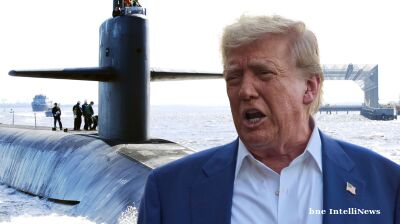Russia’s manufacturing sector saw its most severe contraction in output since early 2022, as demand faltered and firms struggled with financial pressures, according to new data from S&P Global released on August 1. (chart)
The downturn raises questions over the durability of Russia’s industrial recovery and exposes underlying weaknesses masked by wartime fiscal stimulus, S&P Global said.
Russia’s economy is clearly cooling that has recently sparked a debate of if it is facing a recession or if the economy is merely slowing down. Russia’s economy contracted in the first quarter of this year in real terms for the first time since the war started, but at the same time CBR Governor Elvia Nabiullina’s plan to slow the economy using non-monetary policy methods seems to be working.
Inflation is falling faster than expected, falling from a sticky 10% at the end of last year to 9.2% in July. That has given the CBR the room to make 300bp of rate cuts in the last two months and if the trend persists, the CBR says it could make another 300bp of cuts in the next three meetings before the end of the year. Following the last monetary policy meeting last month, Nabiullina said the economy is coming back on track, but big problems remain.
A race is on. Clearly the price the regulator is paying for reducing inflation is slowing growth, but Nabiullina is gambling the slowdown will be offset by the monetary policy easing that will boost growth by reducing interest payments that are eating into profits, and by making the cost of capital cheaper to encourage more investment.
In the meantime, producers are still feeling the pain, squeezed between high interest rates and falling demand. The S&P Global Russia Manufacturing Purchasing Managers’ Index (PMI) fell to 47.0 in July, down from 47.5 in June. A reading below 50.0 indicates contraction.
“The drop in operating conditions was the strongest since March 2022,” the report noted, marking the second consecutive monthly decline and reflecting “a solid deterioration in the health of the manufacturing sector.”
The data revealed a broad-based slowdown across key metrics. New orders fell at their fastest pace in over two years, with panellists citing “weak demand conditions, in part due to financial issues at customers and difficulties receiving payments.”
Output, employment, and purchasing activity all continued to decline. July marked the fifth consecutive monthly drop in production, and “the latest contraction [was] the steepest in three years and strong overall.”
While domestic demand remains subdued, some support came from external markets. S&P Global noted that new export orders increased for the first time in five months, “with companies reporting greater order intakes in existing export markets.” However, this was insufficient to offset the broader domestic weakness.
Despite falling activity levels, inflationary pressures eased, providing some relief to producers. “Selling prices rose at the weakest rate since November 2022,” S&P Global said, with cost inflation now at one of the lowest levels since the current cycle began in 2009. This cooling was attributed to increased competition and reduced input demand, which helped shorten supplier lead times and ease delivery constraints.
Cost-cutting measures dominated the response by firms, with reductions in staffing, inventories and input buying. One of the side effects of the cooling is the chronic labour shortage seems to be easing too. The falling demand has reduced the demand for labour, which has driven the unemployment rate down to a historical low of 2.2% and at the same driven up nominal and real incomes to record highs. But has the economy cools, companies are starting to let some workers go and the rise in nominal wages is slowing, which is reducing inflationary pressures. Again, there is a trade-off between bring the economy back inside “normal” parameters and overdoing it and sending unemployment soaring that will depress demand and slow growth. Currently, the Russian budget earns twice as much from VAT payments than from oil and gas export revenues.
“A fall in output levels sparked continued reductions in employment and input buying during July,” the report found, adding that companies worked through existing backlogs to meet current orders.
Business sentiment has also turned more cautious. While most firms remain optimistic that investment in new products and equipment could help stimulate sales over the coming year, confidence levels fell to their lowest since August 2022. “Financial challenges at customers and economic uncertainty dampened the outlook,” S&P Global said.
The inventory picture added to signs of strain. Stocks of inputs declined for the sixth consecutive month, while cancelled orders led to a rise in unsold finished goods. “The rate of growth [in post-production inventories] was only marginal, but the steepest since June 2023.”
Data

Czech manufacturers PMI falls to 49.7 despite higher output, more orders
Czechia’s manufacturing sector recorded a renewed deterioration in operating conditions in July, despite continued gains in output and new orders, as firms accelerated job cuts and scaled back inventories amid persistent uncertainty.

No end to world hunger by 2030 – Statista
2024 saw some progress in the fight against world hunger after the number of undernourished people rose once again between 2017 and 2021 due to global crises such as the Covid-19 pandemic.

Poland’s inflation falls within central bank’s target in July, flash estimate shows
Poland’s CPI growth eased to 3.1% year on year in July from 4.1% y/y the preceding month, the country’s statistical office GUS said in a flash estimate on July 31. (chart)

Vietnam’s Central Bank raises 2025 credit growth quota to bolster economic expansion
The State Bank of Vietnam (SBV) has announced an increase in the 2025 credit growth quota for commercial banks in a bid to stimulate economic growth, as inflation remains under control.




